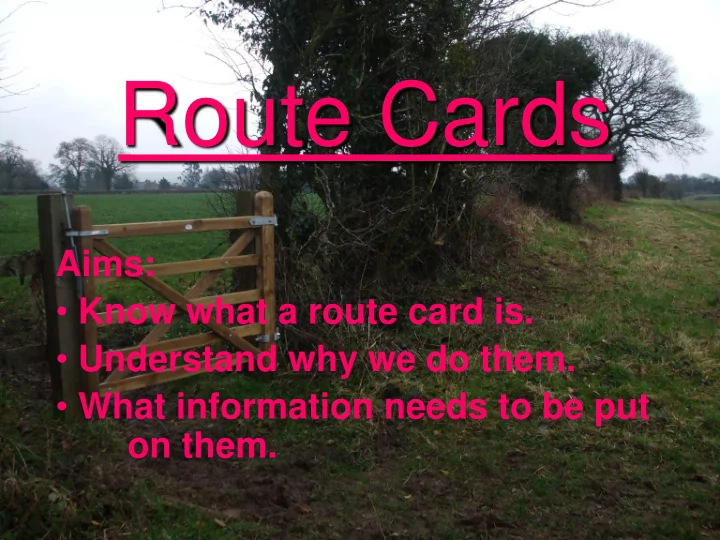

Route Cards Aims: • Know what a route card is. • Understand why we do them. • What information needs to be put on them.
Route Cards • The basic information should be sufficiently detailed so that it is possible to walk without a map should the map become damaged by rain or lost en route.
What is the point? • Your expedition has been planned • You know how long different parts should take – the time whole route takes – and therefore the time you’ll get in • You have thought about emergencies and checking in with team leaders • You have a communication tool for the team, leaders, emergency services, and wider
If a job is worth doing its worth doing well • Route cards should be well presented – It demonstrates • Pride in what you do • Good preparation • An understanding and knowledge of the challenge • Consideration of what to do in an emergency • Need to be able to read them in the pouring rain and howling winds. • They will be sent back if scrappy and illegible
What is a route card? • A route card gives information about the route you will be taking over the course of a day. • This includes: – Timings – Distance – Speed – Breaks – Checkpoints – Start/Finish (camping) points – Escape routes (emergency route )
A Route Card
Aim/Activity • Landscape • Conservation • Land use • Nature • Local community • Group dynamics
Some questions to help you decide what to do? • 1) What would all the group find interesting? • 2) What sort of countryside are you planning to walk through? • 3) What features are there on your planned route? There's no point in doing something about high mountain environments if your route goes through low-level forest and farmland.
Activity Plan
Information that's needed • Its ALL important • Days and dates need to be right! • Full names • Aim - why? • Timings of legs are built up by YOU! • Checkpoint names as well as Grid Refs! • Totals at the bottom sbalance across • Including route details & escape routes show you've planned things and help leaders track you
How to start • Choose the area you are going to walk in. • Use an UP TO DATE 1:25,000 Map • Decide distance – based on your aim usually. (Activity time – 6hrs) • Can be useful to use a length of string to roughly plan your route first of all, also considering your aim, skill level, and climbs • Mark it on your map with a china craft pencil • Check it with a Leader • Prepare your route card
Checkpoints and Campsites • Use designated campsites at Bronze or land with the owners permission (toilet/washing facilities?) • Assessed Expedition has to be in an unknown area • Checkpoints should be a clearly identified point on the ground such as: road/river junction, hill summit, building (vehicle access when you need water?) • a checkpoint also provides a valuable check as to how you're doing time wise • ahead of time? you will have to wait there until you get back onto the time stated on your route card. • if you're late your assessor/supervisor might be stuck there for several hours • SO, plan accurately!
General Direction or Bearing • Bearings are used in wild/open country that you can walk straight across without worrying about footpaths/bridleways • Sometimes useful in your route detail, if you have to choose a track from several that seem to go in the same direction • If you’re using footpaths and bridleways then its more sensible to use a 16 point cardinal compass
THE COMPASS DIRECTIONS YOU CAN USE
Distances • should be to the nearest 0.1km • do not try and "fudge" your distances • total distances are usually (and easily) checked from the map • Inaccurate distances will mean an inaccurate route card – so you’ll either be hanging around waiting or constantly late and doing too much
Calculating walking times • Calculate for the slowest walker • 4k per hour is not unreasonable if you are fit and have good map skills. – i.e. It will take 15minutes to walk 1K, 30mins to do 2K – So, 6k = ?, 3.5 = ? • If heavily laden or hesitant, 3 km in 1hr – i.e. 4.5K = 90min; 6K = 120mins – 2.1K = ? • ALWAYS write your leg timings in minutes
Height Gain – and using Naismith’s Rule • You are expected to take into account any climbs as it will probably take longer! For every 10m climbed allow an extra 1 minute. • Count the contour lines crossed going uphill • Adding time for going down isn't done for local countryside
Time for exploring, rests etc • the group should start walking at a realistic time each morning and arrive at their campsite at a reasonable time. Time must be allowed for stops, lunch etc. • its usually works out about an average of 10minutes per hour • try to use break time to “round up” total time – makes it easier to do ETD
Route Details • Brief and clear, not long and complicated. Make sure you identify the route you are taking so that people know where to look for you if you don’t arrive. • Gradient? Woods? Open? Buildings? Fenceline? Track? • Could use to find the way without a map
REMEMBER - TAKE CARE WITH ROUTE CARDS AND EXPEDITION PREPARATION LIVES MAY DEPEND ON THEM
YOUR TASK • Work in pairs • In Coffee Bar, S Hall, Yellow room • Pencil, map, partially completed route card, compass or romer • NAME your route card with your two names • Complete your route card
Recommend
More recommend